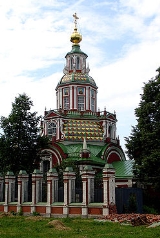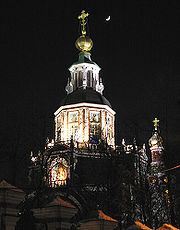
Church of St. John the Warrior
Encyclopedia
Church of St. John the Warrior on Yakimanka Street is a Russian Orthodox
church in Yakimanka District
of Moscow
(55°43′57"N 37°36′40"E) erected in 1704-1717, during the reign of Peter the Great
. It is attributed to architect Ivan Zarudny. The church address is 46, Bolshaya Yakimanka.
were regularly flooded in spring; they were occupied by sloboda
settlements of Streltsy
, Poles
and ordinary farmers.
Legendary accounts link the present-day church with Peter I. Peter, examining the damage done by the flood, noticed the ruined church of St.John (1625). He ordered to rebuild in on a higher, safer lot, and financed the construction to commemorate the Battle of Poltava
. The fence around St.John was erected later, in 1754-1758. In 1779-1791, the church was decorated by Gavriil Domozhirov (fresco
es) and Vasili Bazhenov
(iconostasis
); this artwork was lost in 1860s. In 1928, the church was refitted with an iconostasis taken from the demolished Three Saints church at Red Gates.
After the Russian Revolution
, numerous icons and relics from the churches destroyed by the Communists were stored in the Church of St. John. The church itself operated continuously through the entire Soviet period.
 The church combines elements of the Muscovite baroque style with the Ukrainian baroque
The church combines elements of the Muscovite baroque style with the Ukrainian baroque
and European influences prevalent in Russian architecture
of Peter's reign. Architect remains unknown; similarities with Menshikov Tower
suggest the work of Ivan Zarudny. The main building is a traditional muscovite octagon on a square (восьмерик на четверике), however, this time there are two coaxial octagons, each crowned with a half-dome.
Russian Orthodox Church
The Russian Orthodox Church or, alternatively, the Moscow Patriarchate The ROC is often said to be the largest of the Eastern Orthodox churches in the world; including all the autocephalous churches under its umbrella, its adherents number over 150 million worldwide—about half of the 300 million...
church in Yakimanka District
Yakimanka District
Yakimanka District is a district of Central Administrative Okrug of Moscow, Russia. Population: It is named after the former church of Saint Joachim and Saint Anne...
of Moscow
Moscow
Moscow is the capital, the most populous city, and the most populous federal subject of Russia. The city is a major political, economic, cultural, scientific, religious, financial, educational, and transportation centre of Russia and the continent...
(55°43′57"N 37°36′40"E) erected in 1704-1717, during the reign of Peter the Great
Peter I of Russia
Peter the Great, Peter I or Pyotr Alexeyevich Romanov Dates indicated by the letters "O.S." are Old Style. All other dates in this article are New Style. ruled the Tsardom of Russia and later the Russian Empire from until his death, jointly ruling before 1696 with his half-brother, Ivan V...
. It is attributed to architect Ivan Zarudny. The church address is 46, Bolshaya Yakimanka.
History
The lowlands between present-day Bolshaya Yakimanka Street and Moskva RiverMoskva River
The Moskva River is a river that flows through the Moscow and Smolensk Oblasts in Russia, and is a tributary of the Oka River.-Etymology:...
were regularly flooded in spring; they were occupied by sloboda
Sloboda
Sloboda was a kind of settlement in the history of Russia, Belarus and Ukraine. The name is derived from the early Slavic word for "freedom" and may be vaguely translated as "free settlement"....
settlements of Streltsy
Streltsy
Streltsy were the units of Russian guardsmen in the 16th - early 18th centuries, armed with firearms. They are also collectively known as Marksman Troops .- Origins and organization :...
, Poles
Poles
thumb|right|180px|The state flag of [[Poland]] as used by Polish government and diplomatic authoritiesThe Polish people, or Poles , are a nation indigenous to Poland. They are united by the Polish language, which belongs to the historical Lechitic subgroup of West Slavic languages of Central Europe...
and ordinary farmers.
Legendary accounts link the present-day church with Peter I. Peter, examining the damage done by the flood, noticed the ruined church of St.John (1625). He ordered to rebuild in on a higher, safer lot, and financed the construction to commemorate the Battle of Poltava
Battle of Poltava
The Battle of Poltava on 27 June 1709 was the decisive victory of Peter I of Russia over the Swedish forces under Field Marshal Carl Gustav Rehnskiöld in one of the battles of the Great Northern War. It is widely believed to have been the beginning of Sweden's decline as a Great Power; the...
. The fence around St.John was erected later, in 1754-1758. In 1779-1791, the church was decorated by Gavriil Domozhirov (fresco
Fresco
Fresco is any of several related mural painting types, executed on plaster on walls or ceilings. The word fresco comes from the Greek word affresca which derives from the Latin word for "fresh". Frescoes first developed in the ancient world and continued to be popular through the Renaissance...
es) and Vasili Bazhenov
Vasili Bazhenov
Vasily Ivanovich Bazhenov was a Russian neoclassical architect, graphic artist, architectural theorist and educator...
(iconostasis
Iconostasis
In Eastern Christianity an iconostasis is a wall of icons and religious paintings, separating the nave from the sanctuary in a church. Iconostasis also refers to a portable icon stand that can be placed anywhere within a church...
); this artwork was lost in 1860s. In 1928, the church was refitted with an iconostasis taken from the demolished Three Saints church at Red Gates.
After the Russian Revolution
October Revolution
The October Revolution , also known as the Great October Socialist Revolution , Red October, the October Uprising or the Bolshevik Revolution, was a political revolution and a part of the Russian Revolution of 1917...
, numerous icons and relics from the churches destroyed by the Communists were stored in the Church of St. John. The church itself operated continuously through the entire Soviet period.
Architecture

Ukrainian Baroque
Ukrainian Baroque or Cossack Baroque is an architectural style that emerged in Ukraine during the Hetmanate era, in the 17th and 18th centuries....
and European influences prevalent in Russian architecture
Russian architecture
Russian architecture follows a tradition whose roots were established in the Eastern Slavic state of Kievan Rus'. After the fall of Kiev, Russian architectural history continued in the principalities of Vladimir-Suzdal, Novgorod, the succeeding states of the Tsardom of Russia, the Russian Empire,...
of Peter's reign. Architect remains unknown; similarities with Menshikov Tower
Menshikov Tower
Menshikov Tower , the Church of Archangel Gabriel is a Baroque Russian Orthodox Church in Basmanny District of Moscow, within the Boulevard Ring. The church was initially built in 1707 to order of Alexander Menshikov by Ivan Zarudny assisted by Domenico Trezzini, a team of Italian-Swiss craftsmen...
suggest the work of Ivan Zarudny. The main building is a traditional muscovite octagon on a square (восьмерик на четверике), however, this time there are two coaxial octagons, each crowned with a half-dome.
External links
- Church of St. John the Warrior in Yakimanka Street (Moscow)
- Service schedule, contacts with the clergy www.pravoslavie.ru
- Historical photograph 1882
- Russian: photographs o-moskve.narod.ru

